Abstract
Lateritic nickel deposits frequently contain elevated concentrations of chromium. The recovery of this fraction of chromium resources can enhance the comprehensive utilization of resources while simultaneously reducing the energy consumption and environmental pollution associated with smelting. The objective of this study was to investigate the feasibility and technical challenges associated with the recovery of chromium from lateritic nickel deposits from a mineralogical perspective. To this end, a process mineralogical study was conducted on a lateritic nickel deposit in Indonesia. It was discovered that chromium often occurs as a chromium mineral, chromite, and exhibits significant physical differences from common minerals in lateritic nickel deposits, such as limonite and serpentine, making it suitable for physical beneficiation. Chromite constitutes a mere 3.72% of the ore sample, yet it is enriched with a 63.40% chromium content. Consequently, on the basis of determining the granularity and liberation characteristics of chromite and the occurrence state of chromium, we predicted that the recovery rate could reach 39.47%, constituting a feasible value for chromium recovery. This will enable a more scientific approach to the physical beneficiation process.
1. Introduction
Due to their vast availability and relatively low extraction costs, lateritic nickel ores have emerged as a principal source of nickel. Lateritic nickel ores are typically subjected to hydrometallurgical or pyrometallurgical treatments in the industry, primarily to extract nickel, cobalt, or iron [1,2,3,4]. The presence of chromite and other chromium-containing minerals increases smelting consumption and complicates the extraction process [5,6]. This further escalates the operational costs when chromium management measures are implemented during smelting. As a heavy metal, chromium is characterized by its fine granularity and high reactivity, leading to the gradual leaching of heavy metals. The resultant chromium-laden industrial waste and wastewater pose severe risks to the natural environment and biosafety [7,8,9]. Despite these challenges, chromium remains a vital, strategic metal that is essential to various industries, including the automotive, construction, refractory, and aerospace industries [10]. Accordingly, implementing a pre-recovery process for chromium from lateritic nickel ores before smelting could facilitate the recuperation of chromium and diminish the energy demands and environmental costs associated with ore smelting and waste management.
Numerous scholars and mineral enterprises have explored the separation of chromium, focusing on the smelting processes of chromite, the recovery of tailings, and beneficiation trials that enhance the recovery of valuable metals [11,12,13]. Öztürk and Abakay investigated the possibility of upgrading Konya-Beysehir chromite to produce chromite concentrates suitable for industry. To do so, they optimized the results of the beneficiation test by adjusting the parameters that affect the separation effect of the shaking table, and obtained a concentrate with a Cr2O3 content of 46.89% and a yield of 85.18% from microfine-grained chromite [14]. Pownceby et al. used bulk assays, X-ray diffraction, optical microscopy, scanning electron microscopy (SEM), and automated electron probe microanalyses (EPMA) to identify major gangue impurities, the degree of chromite liberation, and possible beneficiation options. Based on the test results, they suggested that stage crushing, followed by wet gravity concentration, produced a high-quality chromite product that contained >46% Cr2O3 and <1% SiO2 [15]. Research has demonstrated that the mineralogical characterization of ores can predict indicators of industrial utilization. Two important indicators in the industry are the recovery rate of valuable elements and the quality of the concentrate [16,17].
A high recovery rate and superior concentrate quality are indicative of the efficient utilization of mineral resources, which is intrinsically linked to the economic viability of these resources. Process mineralogy, as an academic discipline, focuses on the endowment of mineral resources. Its methodology involves analyzing the particle size distribution, liberation characteristics, and the presence of vein minerals and other embedded features within minerals. It also assesses the state of valuable and deleterious elements across different minerals. This analysis serves as a foundation for determining the recyclability of valuable elements and methods of recycling, thereby enabling the prediction of recovery rates and concentrate quality. Consequently, it aids in the formulation of rational industrial indicators [18]. Through meticulous mineralogical examinations of the chromium state in lateritic nickel deposits, it is possible to make informed predictions about chromium recovery, thereby facilitating the prediction of overall recovery capabilities.
This paper presents a process mineralogy study of a lateritic nickel deposit in Indonesia. It evaluates the comprehensive recycling potential of chromium by analyzing major mineral characteristics, including the granularity and liberation properties of chromium minerals, as well as the distribution of the elements we focus on. The goal is to achieve the efficient, clean, and comprehensive utilization of all the valuable elements in lateritic nickel deposits. This research holds significant implications for the rational and effective development and utilization of these resources.
2. Samples
The samples were obtained from a lateritic nickel deposit in Indonesia and shown to be predominantly brown and clayey (Figure 1A). In order to ensure the representativeness of the samples used for the experimental analyses and to reduce errors with the raw materials [19], the samples in this experiment were obtained by multipoint sampling, mixing, and then splitting, then used to make epoxide resin samples (Figure 1B). The secondary electron image reveals that the mineral particles in the sample are fine-grained and have fuzzy boundaries, with a predominantly flocculated structure, indicating low crystallinity (Figure 2). Additionally, the diffraction spectrum of the sample exhibits strong background noise and poor symmetry in the diffraction peaks, which also suggests that the minerals in the sample have low crystallinity (Figure 3).
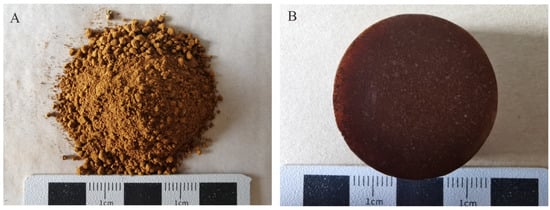
Figure 1.
Sample of the Nickel laterite deposit. (A) Raw sample; (B) Eposide resin sample made from raw samples.
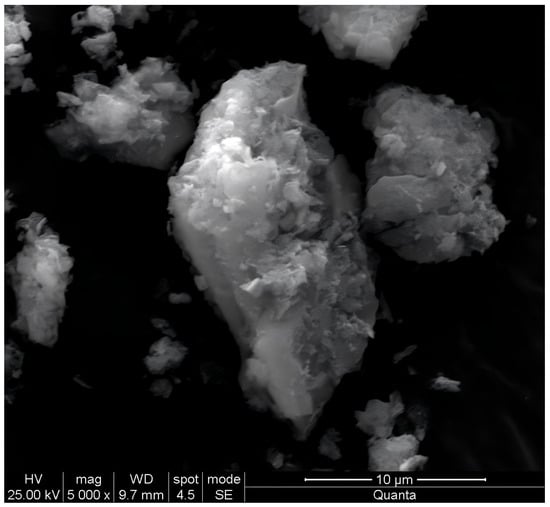
Figure 2.
Secondary electron image of the sample.
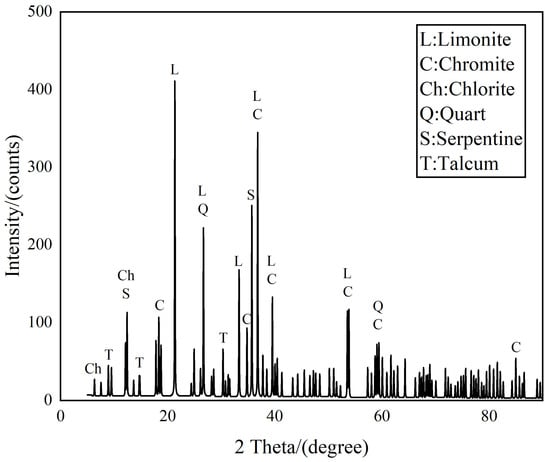
Figure 3.
X-ray diffractogram of raw samples.
Chemical analysis of the samples revealed a composition of 1.17% nickel and approximately 0.10% cobalt, making them suitable for recovery via hydrometallurgy. Notably, the samples contain 2.33% Cr2O3, which feature the potential and the necessity for chromium pre-removal prior to smelting due to its significant recovery value. Detailed chemical compositions are shown in Table 1.

Table 1.
Main chemical compositions of the laterite deposit.
Mineralogically, the chromite is the primary chromium-bearing mineral. Nickel is predominantly found in nickel-bearing limonite and manganese oxides. In addition, minor nickel concentrations are present in silicate minerals such as chlorite, serpentine, and talcum. The diverse mineral composition highlights the complex nature of the sample matrix and difficulty of mineral process, which is crucial for tailoring effective extraction and processing strategies. Detailed chemical compositions are shown in Table 2.

Table 2.
Main mineral compositions of the laterite deposit.
3. Methodology
In order to determine the occurrence state of nickel and chromium, and to provide guidance for the process design of efficiently recovering chromium before the recovery of nickel and cobalt, it is necessary to utilize optical microscopy, scanning electron microscopy, X-ray energy spectroscopy, and laser granularity analysis. These methods should be combined with chemical composition analysis of the ore, as well as chemical phase analysis of nickel, chromium, and iron. After completing the specified tests and analyses, the results should be used to explore the main mineral composition, the dissemination characteristics of significant minerals, the disseminated granularity, and the liberation characteristics of chromium minerals in the samples.
The trace elements of the samples have been analyzed by BGRIMM MTC Technology Co. X-ray diffraction (XRD) analysis was conducted at the X-ray Diffraction Laboratory of the Physical Inspection and Analysis Center of the Institute of Mineral Resources (Beijing, China). This laboratory is equipped with a Rigaku Ultima IV X-ray diffractometer (Tokyo, Japan), operating at a maximum voltage of 50 kV and a current of 50 mA [20,21].
For quantitative analysis, the Automated Mineral Identification and Characterization System (AMICS) (Karlsruhe, Baden-Württemberg, Germany) was utilized, hosted by the Institute of Mineral Resources Research and Design (Beijing, China). The system features an electron microscope with a working distance of 8.5 mm, an operating voltage of 30 kV, and a current of 70 μA. It uses a single-point X-ray acquisition time of 8 milliseconds and operates in a high-vacuum mode, enabling precise and detailed mineralogical assessments of the samples [22].
The mineral composition of the samples was determined based on their elemental composition, which was analyzed using a scanning electron microscope equipped with an X-ray energy spectrometer. The industrial granularity, distinct from crystalline granularity, refers to the spatial dimensions that mineral particles or aggregates occupy to meet the sorting requirements in the beneficiation process. This is assessed using the equivalent ellipsoidal short-diameter method, which was characterized by the surface measurement method [19,23].
Optical microscopy (Oberkochen, Baden-Württemberg, Germany) was employed to capture images of the mineral particles, which were then processed using image analysis software (AxioVision 4). The software measures the area and the maximum chord length of the mineral particles. The area of the particles is considered as that of the equivalent ellipse, and the maximum chord length as the long diameter of the ellipse. The short diameter of the ellipse represents the process particle size of the minerals [19]. It is calculated using the following formula:
where b represents the width of the ellipse, S represents the area of the ellipse, and a represents the length of the ellipse.
The whole sample determination method was used to assess the liberation properties of the minerals. After embedding ungraded samples into epoxy resin sanding sheets, the volume content of monomers and congeners of the target minerals were measured. The degree of mineral liberation was then calculated based on the ratio of the monomer volume to the total volume, using the following formula:
where F represents the degree of liberated mineral, f1 represents the volume of monomer of the mineral, f2 represents the volume of conidia of the mineral [23].
4. Result and Discussion
4.1. Major Mineral Characteristics
The lateritic nickel ore sample contains major minerals such as chromite, limonite, and other silicate minerals. Chromite has a hardness of 5.5 to 6.5, and a density of 4.3 to 4.8 g/cm3, with an average magnetic susceptibility of 286 [24]. Chromite content is relatively low and predominantly occurs in euhedral to subhedral granular texture, often featuring irregular fractures (Figure 4A,B). A small portion of the chromite is cemented with magnetite and limonite, and some are cemented with clayey limonite (Figure 5A,B). The Cr content in chromite varies widely, with Cr2O3 levels primarily ranging from 16.95% to 58.53% (Figure 6 and Table 3). Partial SEM pictures of chromite are attached as Supplementary Figures S1–S5.
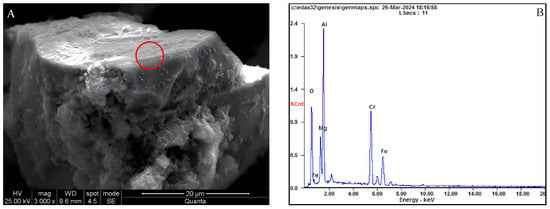
Figure 4.
Secondary electron images and in situ energy spectrum of chromite. (A) Secondary electron images of chromite (The red circle is the test point in figure (B)); (B) Results of in situ energy spectroscopic analysis of chromite.
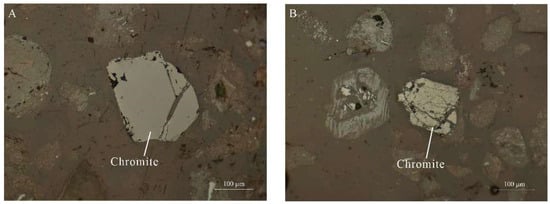
Figure 5.
Photomicrographs of chromite. (A,B), Optical microscope photograph of chromite.
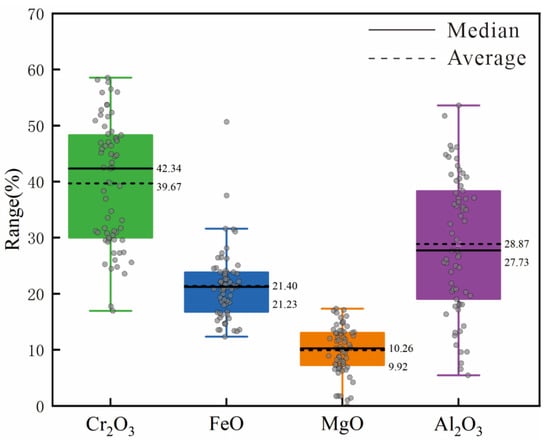
Figure 6.
Boxplot of data from energy spectrum analysis of chromite.

Table 3.
X-ray spectrum analysis results of chromite.
As the predominant mineral component in the sample, Limonite manifests in two categories: cryptocrystalline limonite and limonite (Figure 7A,B). The former is the easily observable clayey limonite mineral, while the latter is the most common mud-like material and the dominant component in this sample (Figure 8). Limonite is characterized by its extremely fine-grained texture, comprising primarily of various iron oxide minerals such as acicular ferrite, hydrous acicular ferrite, hydrous hematite, and fibrous ferrite. Additionally, limonite hosts a diverse array of adsorbed substances including silicate minerals, manganese oxide minerals, and very fine-grained chromium minerals (Figure 9 and Table 4). Partial SEM pictures of limonite are attached as Supplementary Figures S6–S10. In nickel laterite ores, limonite often serves as the main source of nickel. Due to its composition and structure, it is particularly amenable to extraction via wet metallurgical methods. Its adaptability makes limonite the key to the processing of nickel laterites, emphasizing its industrial and economic importance.
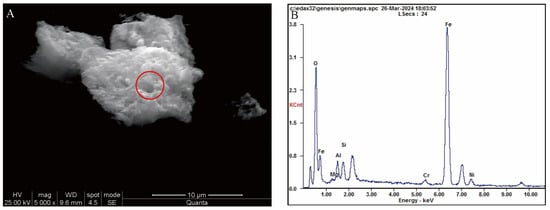
Figure 7.
Secondary electron images and in situ energy spectrum of limonite. (A) Secondary electron images of limonite (The red circle is the test point in figure (B)); (B) Results of in situ energy spectroscopic analysis of limonite.
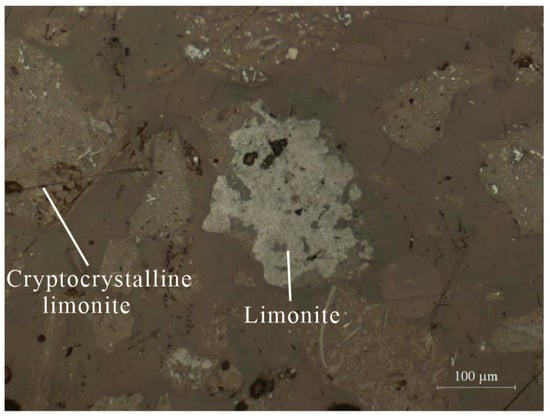
Figure 8.
Optical microscope photograph of limonite.
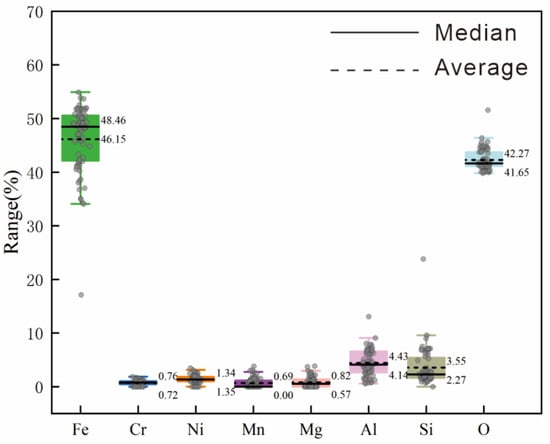
Figure 9.
Boxplot of data from energy spectrum analysis of limonite.

Table 4.
X-ray spectrum analysis results of limonite.
In addition to chromite and limonite, the samples also contain metallic minerals such as manganese oxides and magnetite. The manganese oxides are epithermal. Manganese-bearing minerals dominated by MnO2 and include diverse elements like Fe, Co, and Ni (but notably exclude Cr), exhibit varying crystallinities. While some particles display poor crystallinity and form fine-grained, aggregate-like mixtures, others exhibit good crystallinity. These manganese oxides are often intimately associated with limonite, appearing in argillation and irregular grains with blurred mineral boundaries, typically cemented with limonite.
Magnetite is another significant mineral in the samples, which consist a relative density of 4.9 to 5.2 and a Mohs hardness of 5.5 to 6.5 [25]. Its high specific magnetization coefficient, averaging 92,000, makes it readily separable by magnetic methods. However, the presence of magnetite in the ore is minor, typically occurring as euhedral grains embedded within limonite or cemented alongside limonite and manganese oxides. X-ray spectroscopy analysis reveals that magnetite contains traces amount of Cr and Ni, highlighting its compositional complexity.
Beyond the primary minerals discussed, the sample also comprises amounts of silicate minerals, including chlorite, quartz, serpentine, and talcum, along with lesser amounts of tremolite, diopside, and fayalite. These silicates contain traces amount of nickel, yet notably lack chromium. Although the silicate minerals are present in low concentrations, their influence on the recovery processes, particularly on flotation, should not be overlooked. While they minimally affect the chromium and nickel recovery directly, their impact on the flotation process requires careful consideration to ensure optimal recovery efficiency and process selectivity.
4.2. Influencing Factors of Chromium Recovery
The weathering characteristics and material composition of lateritic deposits provide insights into their genesis. Additionally, the Ultra Magnesian Iron Alteration Index (UMIA) is utilized to assess the geochemistry of lateritic nickel deposits [26,27]:
The UMIA quantifies the loss of Si and Mg elements and the enrichment of Fe elements in lateritic nickel deposits. The UMIA value for fresh peridotite is typically below 10, indicating minimal alteration. Values for the saprolite zone and lateritic zone progressively increase, usually ranging between 40 and 50. The current sample from a lateritic nickel deposit has a UMIA of 81.71, which reflects a substantial loss of Mg and Si and a significant enrichment of Fe. The high UMIA value suggests that the deposit underwent intensive physical and chemical weathering and mineral alteration. The degree of alteration is directly correlated with particle size. More intense alteration typically results in finer particles, which complicates mineral processing. Strong alteration significantly alters the particle size composition and structure of minerals.
Particle size analysis reveals that 72.34% of the total mass distributed under 0.02 mm, which indicates a high proportion of fine particles within the lateritic nickel deposits (Table 5). For the target minerals, coarse and concentrated particle distributions generally reduce the difficulty of beneficiation. However, the particle size distribution of chromite shows low concentrated distribution. While coarser particles can be recovered through beneficiation, but about 37.74% of the chromite is finer than 0.02 mm, making physical separation challenging. The fine-grained minerals smaller than 0.02 mm are primarily nickel-containing cryptocrystalline limonite. This fraction of limonite will encapsulate microfine-grained chromite, making it difficult to separate from each other. We used δ as a measure of chromite enrichment based on the particle size alone. If the ratio of chromite content to total chromite content of the same grain size is significantly greater than the mineral content of the same grade, the recovery value of that grade is considered likely to be greater. The range of grades is called the enriched area. In contrast, the other grain size ranges are barren area. The ratio can be better represented by applying a natural logarithmic process. The calculations show that the interval with a particle size larger than 0.02 mm is the relatively enriched area for chromite, which means that it is more feasible to recover chromite with a particle size larger than 0.02 mm only from the aspect of particle size (Figure 10).

Table 5.
Particle size composition of chromite and all minerals.
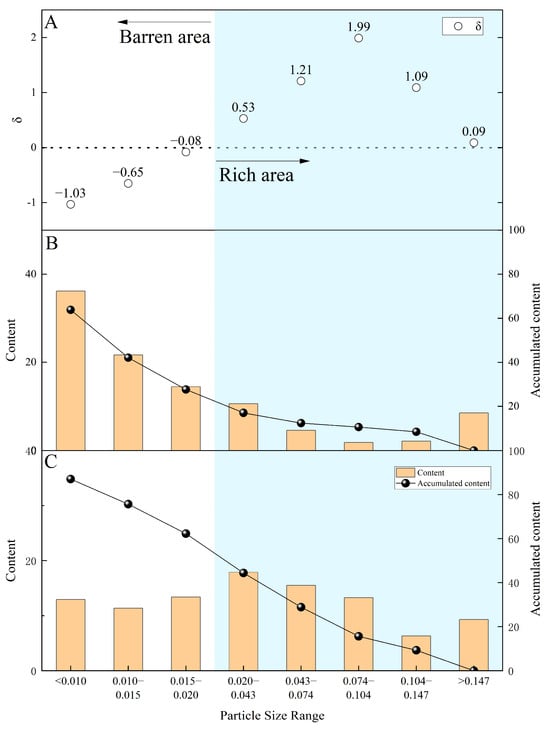
Figure 10.
Particle size characterization diagram of minerals. (A), schematic diagram of the enrichment degree of chromite; (B), Diagram of the particle size distribution characteristics of all minerals; (C), Diagram of the particle size distribution characteristics of chromite in the sample.
This lateritic nickel deposit was formed through intense weathering, resulting in ore samples with a mud-like consistency. Chromite shows more resistant to weathering than other minerals such as limonite or silicate minerals and exhibits distinct characteristics. By analyzing the primary samples, it was determined that the chromite is predominantly liberated. The percentage of liberated chromite particles was found to be 97% or higher.
Phase analysis of chromium, nickel, and iron reveals distinct mineral associations (Table 6). Nickel is predominantly found in limonite, while chromium mainly occurs as chromite, existing as an independent mineral. The primary iron-bearing mineral is limonite, which is accompanied by minor quantities of silicate. Additionally, trace amounts of magnetite and chromite are present. Phases analysis suggested that the deposit is primarily composed of weakly magnetic minerals.

Table 6.
The distribution of chromium, nickel, and iron phases.
We synthesized SEM analysis of the major minerals in the sample and the results of phase analysis to understand the occurrence state of nickel and chromium. Nickel exhibits a complex occurrence state, predominantly associated with limonite, followed by manganese oxides and trace amount of Ni found in serpentine, talcum, and magnetite. Chromium primarily exists in distinct mineral forms like chromite. Notably, 32.56% of the chromium content is found in limonite, with additional traces in chlorite and magnetite. The equilibrium composition of chromium and nickel across these minerals are detailed in Table 7 and Table 8, respectively.

Table 7.
Occurrence state of Chromium in samples.

Table 8.
Occurrence state of Nickel in samples.
The occurrence state of nickel and chromium suggests targeted recovery approaches: chromium primarily from chromite and nickel from limonite. The subsequently designed recovery experiment aims to physically separate chromite and to isolate chromite from chromite and other silicate minerals. In the sample, 63.40% of the chromium is located in chromite, which is our primary recycling target. However, 37.74% of the chromite is finer than 0.02 mm, complicating the recovery of this chromium fraction. Except for chromite, 34.18% of the chromium is hosted in mud-like limonite. Its fine-grained characteristic made it unapproachable for physical beneficiation. In addition, manganese oxide is a class of minerals, which means its density and specific magnetization coefficient are difficult to determine [28]. During the processes of gravity separation and magnetic methods, manganese oxides exhibit a relatively uniform behavior alongside chromite, which complicates their separation. This similarity in behavior adversely impacts the quality of the chrome concentrate, as the separation was inefficient. Furthermore, nickel is not associated with chromite, thus ensuring no nickel loss during the recovery of chromite.
In summary, there are mainly two reasons that affect the improvement of the recovery rate of chromite. The fine-grained nature of chromite is the primary reason that makes it difficult to increase the recovery efficiency. A large amount of fine-grained chromite is encapsulated within limonite, which makes the recovery of this portion of chromite challenging. Secondly, the distribution rate of chromium elements in limonite reaches 34.18%. This particular portion of chromium is hard to recover, which is also one of the major issues that elevate the difficulty to improve the chromium recovery rate. In addition, due to the similarity in magnetism and density to chromite, the manganese oxides in lateritic nickel ores, made physical beneficiation methods indistinguishable between the them, which affects the quality of the chromite concentrate.
4.3. Comprehensive Recycling Process
By carrying the process mineralogy of this deposit, we aim to emphasize two primary issues. First, it is essential to gain a comprehensive understanding of all minerals present in the sample. This facilitates the identification of impurity minerals that need to be eliminated during the chromite enrichment process, thereby defining the optimal processing sequence. Second, by investigating the granularity and liberation of minerals, along with the occurrence states of elements, the theoretical maximum recovery rate can be estimated. This estimate serves as a critical reference for subsequent beneficiation trials, providing a basis for evaluating the efficacy of the beneficiation outcomes. The exploration of these issues is crucial for determining the target of recovery, the sequence of processing steps, and the potential recovery outcomes. It is imperative to conduct such feasibility research on the development of a mineral deposit as it can substantially reduce the temporal and resource expenditures associated with beneficiation and smelting.
Through the aforementioned mineralogical research, we can confirm that the target mineral for chromium recovery is chromite. The impurity minerals that need to be disseminated include limonite, manganese oxides, magnetite, and silicate minerals. The mineral composition of this nickel laterite ore is predominantly limonite, characterized by an extremely fine-grained size and significant argillation. For effective recovery of chromite, initial and deeply desliming of the sample is imperative. Although the desliming process results in the loss of some chromite, it directly removes the majority of limonite and incidentally removes silicate minerals. The minerals that still need to be separated from chromite include manganese oxides and magnetite. Given its high specific magnetization coefficient, magnetite separation necessitates the introduction of magnetic separation technique. After the removal of magnetite, 1.73% of the remaining impurities are manganese oxides. Unfortunately, it is physically challenging to separate manganese oxides from chromite during mineral processing, which may affect the grade of the final product. The granularity and liberation of major minerals, as well as the occurrence state of elements, can guide the prediction of the theoretical recovery rate of chromium. According to the distribution of chromium elements, 63.40% of chromium exists in the form of chromite, and we are only able to recover chromium from chromite. Therefore, considering only the occurrence state of elements, the maximum theoretical recovery rate is 63.40%. In addition, Figure 10 indicates that chromite is relatively more enriched in minerals with a particle size greater than 0.02 mm. The substantial amount of clayey limonite surrounding the fine-grained chromite in the raw ore lead to an inevitable outflow during desliming. The fine chromite fraction (with a particle size less than 0.02 mm) accounts for 37.74% of the total chromite. Since chromite is almost completely liberated, the recovery of chromite will hardly decrease due to liberation. The effective liberation of chromite facilitates beneficiation without the need for further grinding. In summary, it is theoretically possible to recover 39.47% of the chromium in the sample through physical beneficiation methods.
Based on these findings, we propose a process for the recovery of chromium, as illustrated in Figure 11. The beneficiation recovery process for chromium minerals includes several key steps: ore screening, intensive desliming, low intensity magnetic separation (LIMS), high intensity magnetic separation (HIMS), gravity separation, and lastly, the regrinding of middling with a second gravity separation [29,30,31]. Initially, the ore is screened to select coarse chromite particles larger than 0.50 mm. The finer fractions undergo extensive desliming, followed by both LIMS and HIMS, leading to the initial gravity separation [32]. Given chromite’s high density, its separation in this stage is highly effective. The first round of gravity separation produces Concentrate 1. Subsequently, the remaining material is subjected to further fractionation, grinding, and a second gravity separation to produce Concentrate 2. This two-stage approach aims to enhance the overall recovery rate. Following the aforementioned beneficiation process, we executed a series (five rounds) of beneficiation experiments, the details are delineated in Supplementary Table S1. The aggregate outcomes of these experiments revealed that the combined yield of Concentrates 1 and 2 averaged 1.39%, with a mean grade of 33.82% chromium oxide. Additionally, the anticipated recovery rate for chromium oxide (Cr2O3) was determined to be 20.36%. The recovery rate of the experiment only reached 51.58% of the theoretical recovery rate, indicating that it is difficult to recover chromium from laterite nickel ore and there is still great potential for improvement in the future.
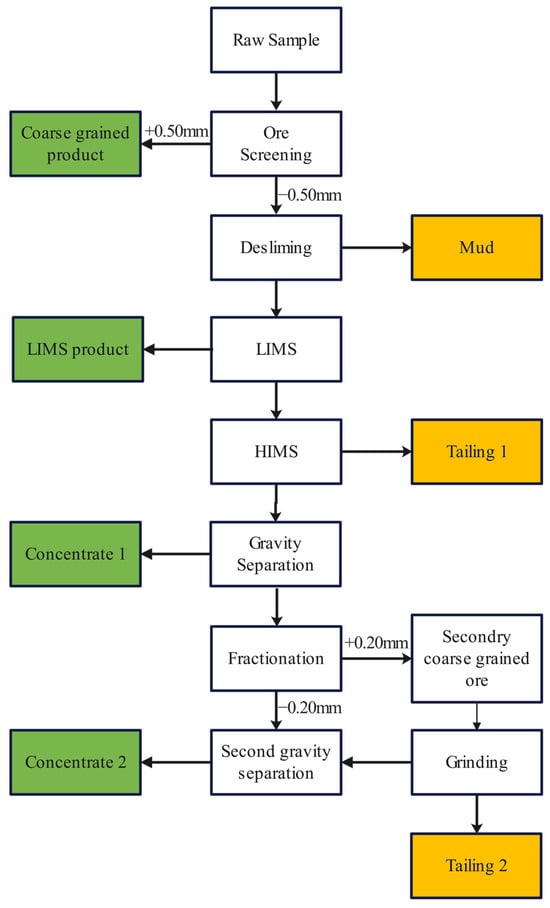
Figure 11.
Recommended beneficiation process flow based on process mineralogical research. The white color is the recommended process flow, the green color is the products produced at different stages, and the yellow color is the tailings section.
5. Conclusions
This exploration emphasized the feasibility of recovering and utilization of chromium from lateritic nickel deposits. The presence of chromium adulteration in these deposits not only increases energy consumption and pollution during the smelting process, but also elevates the treatment costs of smelting slag. By recycling chromite separately, it is possible to produce additional chrome concentrate products, thereby enhancing resource utilization efficiency while simultaneously reducing energy consumption and environmental pollution.
Process mineralogy research of this lateritic nickel deposit reveals that chromite exhibits excellent liberation characteristics. However, due to intense weathering and the coalescence with fine-grained limonite, its fine-grained characteristic complicates physical separation. Additionally, not all chromium is concentrated in chromite. A significant amount is lost when chromium accumulates in other minerals. Theoretically, the deposit has a chromium recovery potential of 39.47%. Practical beneficiation experiment yield about 20.36% recovery. This indicates that approximately 50% of the chromium is recoverable despite the challenges, proving the process to be challenging yet effective.
The study highlights the necessity of a comprehensive prediction of chromium recovery from lateritic nickel deposits by considering three critical aspects: the granularity differential between chromite and other minerals, the liberation of chromite, and the occurrence of chromium. By discovering the proportion of microfine-grained chromite that remains irrecoverable, and the fraction of chromium in minerals like clayey limonite that are challenging to recover through physical beneficiation, a reliable prediction of chromite recovery can be made. This approach not only aids the optimization of the beneficiation, but also provides insights to rationalizing beneficiation indices and designing effective beneficiation processes.
Supplementary Materials
The following supporting information can be downloaded at: https://www.mdpi.com/article/10.3390/min15020161/s1, Figures S1−S5: Photos showing the spots mentioned in Table 3. Figures S6−S10: Photos showing the spots mentioned in Table 4. Table S1: Experimental data of chromite concentrates beneficiation.
Author Contributions
C.X. contributed to the overall writing, the data collection and the data analysis; Y.X. and M.F. conceived the idea; L.L. and K.F. conducted the experiment(s) and data analysis. All authors have read and agreed to the published version of the manuscript.
Funding
This research received no external funding, and the APC was funded by State Key Laboratory of Science and Technology of Mineral Processing.
Data Availability Statement
The data presented in this study are available on request from the corresponding author.
Acknowledgments
This is a contribution from State Key Laboratory of Science and Technology of Mineral Processing. This work was jointly supported by the National Natural Science Foundation of China (Nos. 42102112, 42302082), the State Key Laboratory of Ore Deposit Geochemistry Foundation of Institute of Geochemistry, Chinese Academy of Sciences (No. 202207).
Conflicts of Interest
All authors are employees of BGRIMM Group, but the paper reflects the views of the authors and not the company.
References
- Ma, B.Z.; Yang, W.J.; Wang, C.Y.; Yin, F.; Chen, Y.Q. Progresses of Hydrometallurgy Processes for Nickel Laterite Ores. Nonferr. Met. Extr. Metall. 2013, 7, 1–8. [Google Scholar]
- Mu, W.N.; Lu, X.Y.; Cui, F.H.; Luo, S.H.; Zhai, Y.C. Transformation and leaching kinetics of silicon from low-grade nickel laterite ore by pre-roasting and alkaline leaching process. Trans. Nonferr. Met. Soc. China 2018, 28, 169–176. [Google Scholar] [CrossRef]
- Yuan, S.; Zhou, W.T.; Li, Y.J.; Han, Y.X. Efficient enrichment of nickel and iron in laterite nickel ore by deep reduction and magnetic separation. Trans. Nonferr. Met. Soc. China 2020, 30, 812–822. [Google Scholar] [CrossRef]
- Xu, C.; Xiao, Y.W. Occurrence characteristics of nickel and cobalt in laterite nickel deposits and the effect on its recycling. Nonferr. Met. Extr. Metall. 2024, 3, 50–56. [Google Scholar]
- Sully, A.H. Metallurgy of the Rarer Metals. Chromium; Butterworths Scientific Publication: London, UK, 1954. [Google Scholar]
- Marvin, J.U. Chromium, Metallurgy of Chromium and Its Alloys; Reinhold Publishing Corporation: New York, NY, USA, 1956. [Google Scholar]
- Darrie, G. Commercial extraction technology and process waste disposal in the manufacture of chromium chemicals from ore. Environ. Geochem. Health 2001, 23, 187–193. [Google Scholar] [CrossRef]
- Moon, D.H.; Wazne, M.; Dermatas, D.; Christodoulatos, C.; Sanchez, A.M.; Grubb, D.G.; Chrysochoou, M.; Min, G.K. Long-term treatment issues with chromite ore processing residue (COPR): Cr(6+) reduction and heave. J. Hazard. Mater. 2007, 143, 629–635. [Google Scholar] [CrossRef]
- Jagupilla, S.C.; Moon, D.H.; Wazne, M.; Christodoulatos, C.; Min, G.K. Effects of particle size and acid addition on the remediation of chromite ore processing residue using ferrous sulfate. J. Hazard. Mater. 2009, 168, 121–128. [Google Scholar] [CrossRef] [PubMed]
- Warati, T.; Nansai, K.; Nakajima, K. Review of critical metal dynamics to 2050 for 48 elements. Resour. Conserv. Recycl. 2020, 155, 104669. [Google Scholar]
- Wei, W.G.; Chen, L.W.; Liu, P.F.; Li, M.Z. Study on metallogenic regularity of lateritic nickel deposits in Indonesia. World Nonferr. Met. 2022, 8, 98–100. [Google Scholar]
- Du, J.W.; Zeng, L.; Zhang, S.L.; Xiao, C.; Zhang, G.Q.; Cao, Z.Y.; Li, Q.G.; Wang, M.Y.; Guan, W.J.; Wu, S.X. Complete recycling of valuable metals from electroplating sludge: Green and selective recovery of chromium. Chem. Eng. J. 2023, 467, 143484. [Google Scholar] [CrossRef]
- du Preez, S.P.; van Kaam, T.P.M.; Ringdalen, E.; Tangstad, M.; Morita, K.; Bessarabov, D.G.; van Zyl, P.G.; Beukes, J.P. An Overview of Currently Applied Ferrochrome Production Processes and Their Waste Management Practices. Minerals 2023, 13, 809. [Google Scholar] [CrossRef]
- Öztürk, F.D.; Abakay Temel, H. Beneficiation of Konya-Beyşehir Chromite for Producing Concentrates Suitable for Industry. J. Miner. Met. Mater. Soc. 2016, 68, 2449–2454. [Google Scholar] [CrossRef]
- Pownceby, M.I.; McCallum, D.A.; Bruckard, W.J. Automated and Quantitative Mineralogy Applied to Chromite Ore Characterization and Beneficiation. Minerals 2023, 13, 440. [Google Scholar] [CrossRef]
- Rincon, J.; Gaydardzhiev, S.; Stamenov, L. Investigation on the flotation recovery of copper sulphosalts through an integrated mineralogical approach. Miner. Eng. 2019, 130, 36–47. [Google Scholar] [CrossRef]
- Jiang, Y.; Chen, L.; Duan, S.; Gao, Q.; Yi, F.; Xian, Y. Deep Insight on the Occurrence Feature of Iron Minerals in a Cyanide Leaching Residue and Its Effective Recovery with Magnetic Separation. Minerals 2022, 12, 524. [Google Scholar] [CrossRef]
- Vallejos, P.; Yianatos, J.; Rodriguez, M.; Cortínez, J. Kinetic Response of Industrial Flotation Banks: Effect of Particle Size and Mineralogy. Minerals 2023, 13, 621. [Google Scholar] [CrossRef]
- Lotter, N.O.; Evans, C.L.; Engstrom, K. Sampling—A key tool in modern process mineralogy. Miner. Eng. 2018, 116, 196–202. [Google Scholar] [CrossRef]
- Deng, L.M.; Ge, X.K.; Fan, G.; Ting, L.; Yu, A.P.; Wang, T. Quantitative Analysis of Minerals Based on Scanning Electron Microscopy and Energy Dispersive Spectrometry—A Case study of AMICS. World Nucl. Geosci. 2023, 40, 98–105. [Google Scholar]
- Hirsch, P.B. Elements of X-Ray Diffraction. Phys. Bull. 1957, 8, 237–238. [Google Scholar] [CrossRef]
- Whittig, L. X-Ray Diffraction Techniques for Mineral Identification and Mineralogical Composition. In Methods of Soil Analysis: Part 1 Physical and Mineralogical Properties, Including Statistics of Measurement and Sampling; Wiley: Hoboken, NJ, USA, 2015. [Google Scholar]
- Xiao, Y.W. Process Mineralogy; Science Press: Beijing, China, 2020. [Google Scholar]
- Sully, A.H.; Brandes, E.A. Chromium; Butterworths: London, UK, 1967. [Google Scholar]
- Klein, C. The Manual of Mineral Science; John Wiley & Sons, Inc.: New York, NY, USA, 2007. [Google Scholar]
- Aiglsperger, T.; Proenza, J.A.; Lewis, J.F.; Labrador, M.; Svojtka, M.; Rojas-Puron, A.; Longo, F.; Durisova, J. Critical metals (REE, Sc, PGE) in Ni laterites from Cuba and the Dominican Republic. Ore Geol. Rev. 2016, 73, 127–147. [Google Scholar] [CrossRef]
- Gao, Y.; Deng, J.H.; Yang, X.Y.; Duan, L.A.; Luo, X.D. Migration and enrichment of elements in the nickel laterite weathering crust of the tropical region: A case study of the Pili Nickel deposit in the Surigao district, southern Philippines. Geol. Rev. 2022, 68, 1839–1852. [Google Scholar]
- Wang, P. Systematic Mineralogy; Geology Press: Beijing, China, 1984. [Google Scholar]
- Bodas, M.G.; Saha, A.K.; Rao, A.S. Chemical benefication of nickel overburden of Sukinda mining corporation. Trans. Indian Inst. Met. 2002, 55, 557–560. [Google Scholar]
- Altin, G.; Inal, S.; Alp, L. Recovery of Chromite from Processing Plant Tailing by Vertical Ring and Pulsating High-Gradient. In Proceedings of the Magnetic Separation. International Black Sea Mining & Tunnelling Symposium, Trabzon, Turkey, 2–4 November 2016. [Google Scholar]
- Mokoena, T.; Nheta, W. Beneficiation of South African chromite tailings using Magnetic Separation. In Proceedings of the 6th World Congress on Mechanical, Chemical, and Material Engineering, Prague, Czech Republic, 16–18 August 2020. [Google Scholar]
- Rao, A.; Rath, R.K.; Mohanta, M.K.; Dey, B.; Sahoo, M.; Singh, R. Beneficiation Studies on Low Grade Chromite Ores using Multi Gravity Separator. In Proceedings of the International Seminar on Mineral Processing Technology, Jakarta, Indonesia, 23–24 October 2017. [Google Scholar]
Disclaimer/Publisher’s Note: The statements, opinions and data contained in all publications are solely those of the individual author(s) and contributor(s) and not of MDPI and/or the editor(s). MDPI and/or the editor(s) disclaim responsibility for any injury to people or property resulting from any ideas, methods, instructions or products referred to in the content. |
© 2025 by the authors. Licensee MDPI, Basel, Switzerland. This article is an open access article distributed under the terms and conditions of the Creative Commons Attribution (CC BY) license (https://creativecommons.org/licenses/by/4.0/).